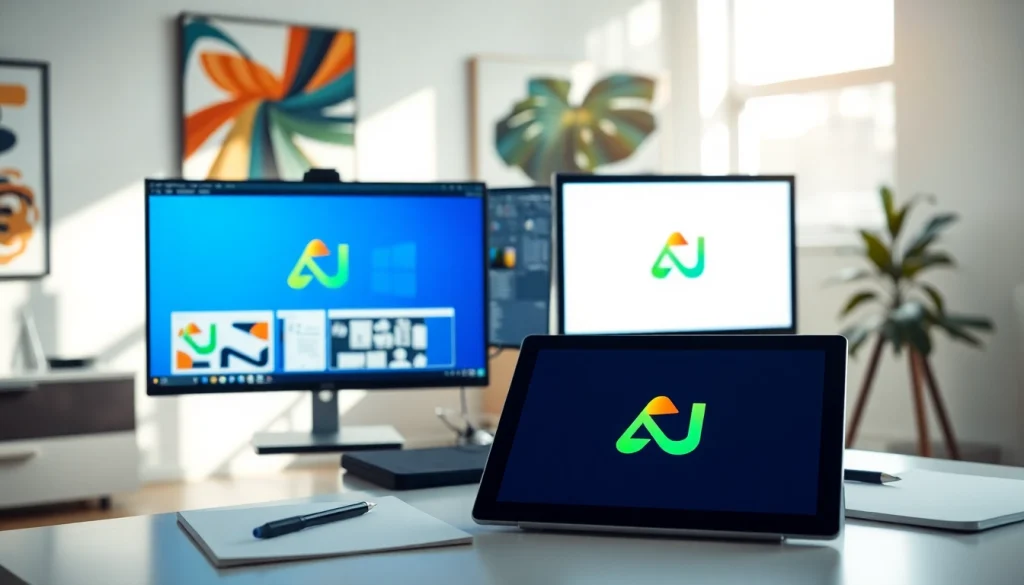
Understanding Custom AI Logo Design
What is Custom AI Logo Design?
Custom AI logo design refers to the process of creating a unique and personalized logo using artificial intelligence (AI) technologies. Unlike traditional logo design, where human designers rely on creativity and experience, AI logo generators use algorithms to produce logos based on input parameters such as business name, industry, color preferences, and design style. This approach allows for rapid generation of logo options that can be customized to meet individual branding needs. With the rise of digital technologies, leveraging an AI-driven solution for logo design has become increasingly popular among startups, small businesses, and even established brands looking to refresh their identity.
Benefits of Using AI in Logo Creation
The integration of AI into logo design offers a multitude of benefits:
- Speed: AI logo generators can produce numerous logo variations in just a few seconds, allowing businesses to visualize different design concepts quickly.
- Cost-Effective: Hiring a professional designer can be expensive. An AI logo generator typically provides budget-friendly options, making it an attractive alternative for small businesses.
- Accessibility: With online AI logo generators, anyone can create a logo without needing graphic design skills. This democratizes access to professional branding tools.
- Innovative Designs: AI can analyze trends and styles from a vast database, offering modern and diverse design suggestions that might not be readily apparent to human designers.
- Customization: Many AI generators allow users to tweak and modify designs, ensuring that the final product aligns with the brand’s vision.
Key Features of AI Logo Generators
When exploring options for a custom AI logo design, several key features can enhance the user experience:
- User-Friendly Interface: An intuitive design interface makes it easier for users to navigate through the logo-building process.
- Variety of Templates: Access to pre-designed templates that can be customized according to the user’s needs.
- Multiple Formats: Generators that provide logos in various file formats (SVG, PNG, JPG) ensure compatibility across platforms.
- Branding Tools: Some platforms offer additional branding tools like business card templates and social media kits allowing for cohesive brand development.
- Real-Time Editing: Users can see changes and adjustments in real time, facilitating an enjoyable design experience.
Choosing the Right AI Logo Design Tool
Comparative Analysis of Top AI Logo Generators
With an array of AI logo design tools available, navigating your options can be overwhelming. Here’s a comparative analysis of some top platforms:
| Tool | Key Features | Pricing Model | Best For |
|---|---|---|---|
| Canva | Extensive templates, easy-to-use editing tools. | Freemium; premium features available. | Beginner designers and those seeking collaboration. |
| LogoAI | AI-driven design, brand kit creation. | Subscription-based. | Business professionals wanting a complete brand identity. |
| Looka | Smart logo suggestions, multiple branding assets. | Pay-per-logo model. | Users looking for a seamless branding solution. |
| LogoMakr | Drag-and-drop interface, free downloads available. | Pay to download higher resolution files. | Small businesses needing quick, low-cost logos. |
Factors to Consider When Selecting Tools
When choosing an AI logo design tool, consider the following factors:
- User Experience: Look for tools that offer a simple and engaging design process.
- Customization Options: Assess how much customization is allowed; the best tools offer a balance between AI-driven suggestions and manual adjustments.
- Quality of Outputs: Ensure that the logo designs generated are professional and high quality.
- Customer Support: Reliable customer support can assist users in troubleshooting any issues they may face while using the tool.
- Integration with Other Tools: If you plan on expanding your branding efforts, tools that integrate well with business or graphic design software will be advantageous.
User Reviews and Success Stories
User reviews provide insight into the effectiveness of different AI logo generators. Many users praise platforms like Looka and Canva for their ease of use and the quality of logos produced. For instance, small business owners report a higher engagement rate after rebranding with a fresh logo generated from these tools. Furthermore, success stories from renowned startups illustrate how well-designed logos can enhance brand recognition and user trust.
Step-by-Step Guide to Creating Your Logo
Setting Your Brand Identity
The first step in designing a custom AI logo is to establish a solid brand identity. Consider the following aspects while defining your brand:
- Target Audience: Understand who you are designing for. Your logo should resonate with your demographic.
- Brand Values: Identify the core values and messages you want your logo to convey.
- Brand Personality: Decide if your brand will be seen as playful, serious, luxurious, or approachable. This will significantly shape your logo’s visual style.
- Competitor Analysis: Reviewing logos of competitors can provide inspiration and ensure your design stands out.
Designing with AI: Best Practices
To design effectively using AI tools, consider these best practices:
- Be Specific with Inputs: The more specific your inputs are, the better the AI can generate relevant logo designs that reflect your brand.
- Iterate: Use the AI tool to output various designs, then select, modify, and iterate on those designs.
- Seek Feedback: Share preliminary designs with peers or potential customers to gather constructive feedback before making a final decision.
- Compare Outputs: Don’t settle for the first good design. Compare multiple options and analyze what works best.
Customizing Your Logo for Diverse Platforms
Once you’ve created a logo design, ensure that it is adaptable for various platforms. This means:
- Variations: Create different versions of your logo (e.g., color, black and white, symbol-only) for flexibility across mediums.
- Responsive Design: Ensure that your logo looks good on both web and mobile formats, with appropriate scaling and resolution.
- Social Media Considerations: Tailor your logo for social media profile pictures and cover photos, as these often require different dimensions.
Common Challenges in AI Logo Design and Solutions
Dealing with Design Limitations
AI design tools can sometimes produce designs that feel generic or lack creativity. To mitigate this, users should:
- Experiment with various inputs to see how minor changes can drastically alter the output.
- Combine AI-generated designs with hand-drawn elements or other bespoke graphics for a unique touch.
- Utilize advanced settings or features within the platform to further refine the designs.
Addressing User Preferences and Feedback
Gathering user feedback on logo designs can be subjective and varied. Teams should:
- Conduct structured surveys to gather quantitative data on user preferences.
- Hold focus groups to gain qualitative insights—this can often reveal preferences that surveys miss.
- Utilize A/B testing with different designs to evaluate performance across real-world applications.
How to Ensure Quality Control
To maintain a high standard of quality in AI-generated logos, it is important to:
- Incorporate a review process for logos before finalizing them; involve stakeholders for extra perspectives.
- Standardize criteria for evaluation of designs, such as uniqueness, relevance, and aesthetic appeal.
- Keep updated with the latest design trends to ensure that AI tools produce modern and appealing logos.
Measuring the Impact of Your Custom AI Logo Design
Evaluating Logo Effectiveness
Once you have deployed your custom AI logo, evaluate its effectiveness with metrics such as:
- Brand Recognition: Conduct surveys to see if prospective customers can remember your brand by its logo alone.
- User Engagement: Monitor website analytics to determine if there is increased traffic post rebranding.
- Sales Metrics: Assess sales performance following the launch of the new logo to identify potential correlations.
Utilizing Analytics for Brand Visibility
Utilizing websites and social media analytics can provide insights into how your logo is perceived. Track metrics such as:
- Impressions and reach across social media campaigns featuring the logo.
- Engagement rates (likes, shares, comments) to understand how well the brand resonates with your audience.
- Website bounce rate and +time spent on page post-rebrand to identify if users are responding positively to the design.
Case Studies: Successful Brand Transformations
Consider the case of a small startup that used a custom AI logo design generator to revamp its branding. After deploying the new logo, they reported a 30% increase in customer engagement and a surge in their social media following. Similarly, established brands that have adopted AI tools for logo creation often cite improved brand identity coherence across various platforms and new customer acquisition rates. These transformations illustrate the potential impact of an effective logo designed with AI.





